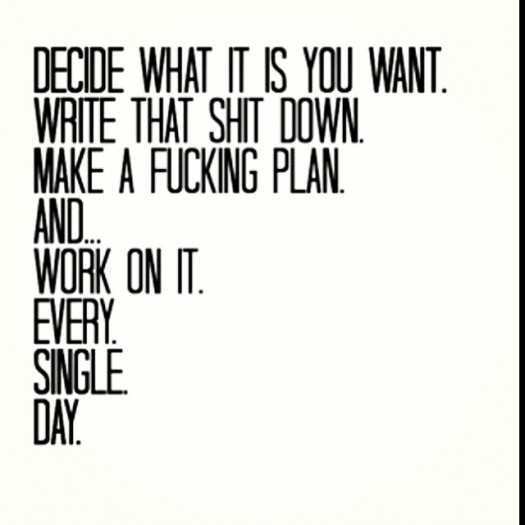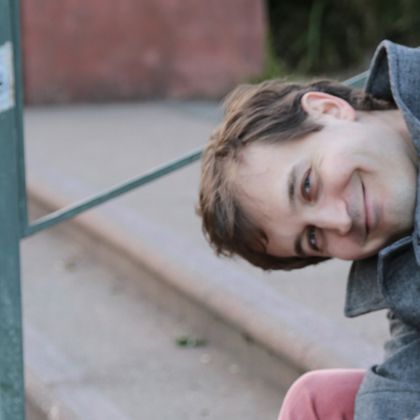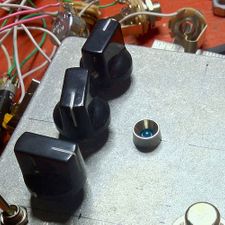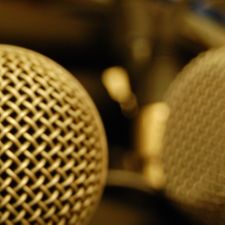CC by TakingITGlobal via Wikimedia Commons
Most Artists Don’t Really Get Creativity
Too many artists embrace a mystical, new-agey approach to creativity that is completely counterproductive. There’s nothing magical about being creative; it’s just something you train your brain to do through practice. It’s part biology and part routine, and Chuck Close perhaps sums it up most eloquently when he says, “Just show up and get to work.” The way I write music is not mathematical by any stretch of the imagination, and I rely heavily on intuition, but fairytales are not required.
I wonder sometimes if new-agey, feel-good attitudes in the arts are simply the unfortunate byproduct of an artistic temperament: a sort of mental ground hum that comes from plugging the creative mind into the same neurons that power other human emotions. Maybe so, but when I read something like Mason Currey’s Daily Rituals, it becomes very clear that the world’s great artists are overwhelmingly immune to any such interference. They have strongly engrained routines, yes, and they may guard those to the point of superstition. They may also lead highly religious or mystical lives outside of art. But when it comes to the nuts and bolts of the creative act itself, great artists are extremely down to earth.
The mystical “commune with nature” stuff is entirely the purview of hacks and also-rans. And it’s aggravatingly insidious! Lots of artists manage to be quite mystical about their craft without so much as waving a single incense stick about their studios. However, their lack of awareness doesn’t make it any less problematic.
Shouting into waterfalls
I watched a documentary recently called Intangible Asset no.82, about Australian jazz drummer Simon Barker, who goes to Korea to locate an aging pansori musician/shaman named Kim Seok-Chul (designated Intangible Asset no.82; the Korean Cultural Heritage Association bestows the title Intangible Asset on important people, sort of like a knighthood).
Kim is an amazing musician by every definition of the term, and I have no trouble understanding why Barker would spend years tracking the guy down. Yet the documentary about Barker’s journey is almost entirely devoted to creating a mystical aura around the aging master. Wherever Barker goes, people speak in hushed tones about Kim Seok-Chul, as if the mere mention of his name were sacrilege. Communication only occurs indirectly through intermediaries, conjuring a veil of mystery about whether Barker will ever get to meet the musician. Never does his guide—who only takes Barker on after he successfully passes a series of hidden challenges—simply pick up the phone to set up a meeting: “It’s not that easy to meet a grand master like Kim Seok-Chul.” Instead, they travel haphazardly around Korea, meeting musicians and talking about the pansori tradition.
At one point, Barker takes “mourning lessons” so that he can be worthy of Kim Seok-Chul’s presence. The lessons consist of throwing himself to the ground, pretending that his mother had just died. The teacher then grades him on whether or not he has demonstrated a sufficient degree of grief. At another point, Barker spends some time with a pansori singer who, for seven entire years, literally stood in a waterfall and screamed at the rocks for 18 hours a day to discover his voice (spoiler: it’s kind of raspy). Whenever someone mentions the spirits of the ancestors or the act of channeling nature through one’s music, Barker nods knowingly, as if these statements were no less controversial than “vegetables are good for you.” And when tensions arise, Barker laments at not being able to “work things out with the drums” like he usually does—because obviously the act of jamming together is the sine qua non of clearing up misunderstandings between strangers from different cultures.
When Kim and Barker finally meet, it’s extremely anticlimactic. Intangible Asset no.82 turns out to be an exceedingly normal guy. He doesn’t have the mystical air of the Dalai Lama or the decorum of the Pope, he doesn’t hold court or try to impart wisdom on his foreign visitor, and he is not particularly charismatic. He even comes across as a little dim-witted, I hesitate to admit. Kim Seok-Chul is just a good-natured, octogenarian from the middle of nowhere—one who happens to be among the greatest percussionists of his generation, yes—but the mystical baggage does not come from him. It has been tacked onto his reputation by groupies. He was too busy actually being creative to get wrapped up in that nonsense.
Learning from another culture doesn’t have to be so fraught. In the early aughts, I went to Cuba to study the drumming of Santería, another shamanistic musical tradition. I auditioned informally at the Ballet folklórico nacional, then I studied twice daily with a couple of master drummers. Granted, they weren’t as renowned as Kim Seok-Chul, but our lessons were all about the music and never once did they bring up anything mystical. In fact, I had to press them to find out anything about the cultural context. Toward that end, I eventually garnered an invitation to attend a Santería ceremony at a home in Havana. The people at the ceremony were welcoming, and they were tickled that I wanted to learn their music. No mystical advice was proffered, however.
Had I been forced to go through a process like Barker’s, my money would have run out long before I started learning any music. Instead, I learned to play the entire Oru del Igbodu from memory, a 20-minute cycle of sacred music for three batá drummers. And that in turn proved to be an invaluable musical perspective that has influenced my approach to rhythm and form ever since.
Natural isn’t always better
I don’t know how many times I’ve heard a composition or performance described as natural or organic. It’s an idea that is so common that we hardly even notice it. But it’s also an overly simplistic, romantic perspective that has nothing to do with what’s actually going on. More often than not, naturalism gets dragged out as an easy way to justify half-baked musical choices.
Let’s remember that nature isn’t all bunny rabbits and sunshine. Naturally, humans have an average life expectancy of about 30. Naturally, people live as hunter-gatherers on the Savannah and are wiped out periodically by famine or disease. Naturally, organisms compete violently to see who is better fitted for survival—a full 15% of paleolithic humans died violent deaths, compared to 0.0065% in the US today. When people call their art natural or organic, what they’re really saying is that it conforms to their own personal conceptions of perfection—which are not natural, by definition.
You want to understand how nature works? Look at the infamous Irish potato famine of 1845. Following the decimation of Europe’s potato crops and the deaths of millions of Irish, botanists frantically started work on what would become the first pesticide, Bordeaux Mixture, so named because it was tested on vineyards in the famous wine region. This pesticide—which, by the way, is allowed in organic farming despite being toxic enough to kill farm workers—was very successful at first. Late blight (the potato disease) was virtually unheard of wherever farmers sprayed. Yet over time, the disease evolved a resistance, to the point that by the 1930s some areas were experiencing complete crop failure again. Luckily, farmers had also been trying to breed blight-resistant varieties of potatoes, so along with a new generation of pesticides, these cultivars allowed humans to buy some time. But of course the disease didn’t take this lying down, and it’s been back-and-forth trench warfare ever since.
Nature doesn’t care if you live a happy, fulfilling life, it just wants to see who can pop out the most babies before being thwacked by the next guy. Biologically, music evolved as a group-bonding mechanism, so as long as your music brings people together in solidarity, it is fulfilling its natural function—which isn’t saying much: “natural” puts you in the company of Vegas showtunes, drinking songs, and advertising jingles. But maybe a particular musical form is more natural than another, you say? Nonsense. That’s like saying that Chinese is more natural than English. Neither are natural; they are both products of culture.
Okay, so maybe your music isn’t really natural, but it’s at least natural in the metaphorical sense of conforming to a specific conception of artistic perfection, right? In that case, you’ve got your metaphors crossed. It would be more accurate to label this case something like GMO music: after all, we’re talking about music purposefully designed to have specific traits that match an artificial, predetermined concept of desirability. That’s exactly what genetic engineers do.
True creativity is a product of the trained human mind, it is not natural. Sure, you can be inspired by nature, but be weary of the artist that steeps his/her work in naturalism—at best, it’s a marketing gimmick. More likely, it’s just a sign that the artist hasn’t really thought things through. Somewhere in that artist’s process is a blindspot; one that typically makes the work a lot weaker than it could have been. Self-awareness, not excuses, breeds strong art.
The myth of free improvisation
Certain types of free improvisation also have a tendency toward substituting actual creativity for mysticism. When people say they’re doing free improvisation, most of the time the thing they’re actually doing is not so much free as it is habitual. Unless forced otherwise by some structure, we have a tendency to do what is most comfortable. Non-improvising interpreters put effort into learning music that pushes them in new directions and leads to self-discovery. Similarly, more traditional improvisers work within boundaries that force them to stretch themselves, again leading to self-discovery. Free improvisers, on the other hand, are at much greater risk of falling back on clichés.
This is why so many free improv performances sound essentially identical. Yes, they’re technically all unique little snowflakes, but the human mind does not have an infinite capacity for appreciating shades of grey. You could say that, in actual practice, there are a handful of “pieces” in the free improv repertoire that are known collectively and interpreted, with minor variation, by the vast majority of practitioners—there’s probably less variety in free improv than in a jazz fakebook.
This is not to say there aren’t some great free improvisers. I have met a few truly amazing ones in my time, and these artists go through elaborate mental gymnastics in order to get beyond their habits. Pianist Craig Taborn has described his routine in detail to me, and we’ve had long conversations about improvisation and creativity. His improvisatory practice (as I understand it) consists of a series of mind-clearing exercises that prevent him from being able to call on his habits. He plans nothing prior to performing. He actively distracts his musical thought while playing. It’s all about keeping his mind in the immediate present, detaching from the human desire to plan, to make goals. In a way it’s very zen—and the 8-12 hours he spends at the piano every day, year in and year out, makes for an equally monk-like routine.
That said, Craig is an exception, one who lives a certain type of life in order to be able to play the music that he loves. Most free improvisers come to the tradition focusing primarily on how it makes them feel. Of course it’s a wonderful rush to get up on stage and play your instrument to the best of your ability with a bunch of other musicians, listening to each other and crafting your lines in real time, never knowing what comes next. It feels liberating and magical, and certain musicians therefore see free improv as a more direct, communicative mode of performance.
The mistake is in believing that the way you feel when you play music has any relationship to the way the audience feels. I’ve been to countless free improv sessions where the performers were obviously having fun but the music coming off the stage was a boring, unoriginal mishmash of clichés. You know what the word is for an activity that is pleasurable to do but not as much fun to watch? Masturbation. If you want to put on a great performance, the audience comes first—it doesn’t matter how you feel. As actress Kerry Washington says, “There’s really nothing sexy about shooting sex scenes. It’s awkward and uncomfortable and you try to figure out a way to make it believable and authentic but you’re surrounded by the crew who are like family. It’s weird.”
Creativity in free improv does not stem from “just feeling it,” from tearing down the boundaries of structure so you can communicate more directly with the audience—those approaches are no different from speaking in tongues. Creativity in free improv requires endless practice, monastic devotion, and the hardcore determination of an ascetic aspiring to overcome his or her ingrained proclivities. As far as artistic disciplines go, it is probably one of the hardest paths to creativity the human mind has yet devised. Done wrong, you’ll spend your entire life circling the same ground over and over, all the while fooling yourself into believing that you’re some kind of daring explorer.
Stretching the creative muscle
I’ve been rather blunt in my criticism, so I want to again stress the idea that creativity is a skill. It develops over time, with practice. Nobody is born an olympian, and there’s no shame in trying to do something great but not quite getting there. Every year, I find that I compose faster and (humbly I submit) better than the year before, but that’s because I keep on working at it, day after day.

If you’re a free improviser, I’m not encouraging you to give up your craft, I’m simply asking you to take an honest look in the mirror. Then keep working, refining, discovering the solutions that are true to who you are. With hard work and determination, you may eventually reach a point where you are actually improvising freely.
The same principle holds true for all artistic disciplines. Whatever truths you believe are self-evident, they should be examined and smashed to pieces periodically if you intend to create art that is worth showing to the world. Because let’s face it: most art is terrible. Less than 1% of 19th-century art has survived to today, and less than 1% of that is actually used on a regular basis. Why? Because most of it was shit, just as most of the music being written today is shit. In fact, I’d wager that the majority of composers alive today have never even attended the premiere of a piece that will end up in the 21st-century canon, let alone written one. That’s just how the statistics fall.
The larger question is: what do you want from your art, why are you doing this? For me, the challenge is to go beyond my comfort zone and hopefully, if I work hard and am very lucky, create some art that matters, that will last. That’s why unraveling true creativity is so important to me, and why I don’t have time for the mystical half-truths that make up so much of artistic watercooler fodder. You won’t always be around to talk up your art, so make sure it can speak for itself.




